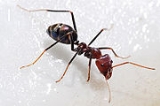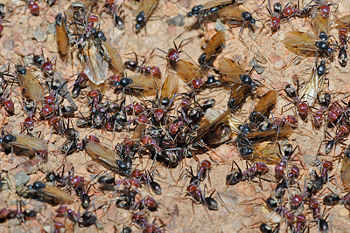
Iridomyrmex
Encyclopedia
Iridomyrmex is a genus
of ant
s that belongs to the subfamily Dolichoderinae
. There are 79 species and subspecies that belong to this genus and they range from India
to China
to Australia
and New Caledonia
.
above the mandibles highly modified with convex areas towards the sides and a central projection, which varies from strongly to weakly developed. The compound eyes are relatively high on the head and away from the mandibles.
 Iridomyrmex ants are generally aggressive to other ants. They form large nests (from several hundred to over 300,000 workers), which limits the number of competing nests that can be formed in a given area. Often, the only neighbouring ant species that can co-exist are those that are of different size or those that forage for food at different times, thus limiting contact with the Iridomyrmex ants. They can be territorial even with ants of their own species but from different nests.
Iridomyrmex ants are generally aggressive to other ants. They form large nests (from several hundred to over 300,000 workers), which limits the number of competing nests that can be formed in a given area. Often, the only neighbouring ant species that can co-exist are those that are of different size or those that forage for food at different times, thus limiting contact with the Iridomyrmex ants. They can be territorial even with ants of their own species but from different nests.
Nests may be above or below ground, with some species such as I. conifer alternating between the two. Meat ant
s (I. purpureus) are known to create "super-colonies" of many small nests that are connected together, reaching as large as 650 metres in length.
s. They will collect these seeds and remove the elaiosomes, discarding the seeds afterwards. The seedlings that sprout from these seeds benefit from the aggressiveness of the Iridomyrmex ants, giving them a better chance of survival.
Caterpillar
s of certain butterfly species have a symbiotic
relationship with Iridomyrmex ants. They produce secretions that the ants will feed on. In extreme cases, the ants will carry the caterpillar back to their nests where they will protect it. These ants may also tend to aphid
s and coccids, collecting nectar when possible.
of Iridomyrmex ants. There are species of spider
s that can detect the ants' chemical communications and selectively target injured members. Ground beetles also have been known to create burrows near ant nests and prey on passing workers.
The Thorny Devil
is also a major Iridomyrmex predator.

Genus
In biology, a genus is a low-level taxonomic rank used in the biological classification of living and fossil organisms, which is an example of definition by genus and differentia...
of ant
Ant
Ants are social insects of the family Formicidae and, along with the related wasps and bees, belong to the order Hymenoptera. Ants evolved from wasp-like ancestors in the mid-Cretaceous period between 110 and 130 million years ago and diversified after the rise of flowering plants. More than...
s that belongs to the subfamily Dolichoderinae
Dolichoderinae
Dolichoderinae is a subfamily of ants, which includes species such as the Argentine ant , the erratic ant, the odorous house ant, and the cone ant. This subfamily is distinguished by having a single petiole and a slit-like orifice, rather than the round acidopore encircled by hairs that typifies...
. There are 79 species and subspecies that belong to this genus and they range from India
India
India , officially the Republic of India , is a country in South Asia. It is the seventh-largest country by geographical area, the second-most populous country with over 1.2 billion people, and the most populous democracy in the world...
to China
China
Chinese civilization may refer to:* China for more general discussion of the country.* Chinese culture* Greater China, the transnational community of ethnic Chinese.* History of China* Sinosphere, the area historically affected by Chinese culture...
to Australia
Australia
Australia , officially the Commonwealth of Australia, is a country in the Southern Hemisphere comprising the mainland of the Australian continent, the island of Tasmania, and numerous smaller islands in the Indian and Pacific Oceans. It is the world's sixth-largest country by total area...
and New Caledonia
New Caledonia
New Caledonia is a special collectivity of France located in the southwest Pacific Ocean, east of Australia and about from Metropolitan France. The archipelago, part of the Melanesia subregion, includes the main island of Grande Terre, the Loyalty Islands, the Belep archipelago, the Isle of...
.
Description
Unlike other genera in Dolichoderinae, Iridomyrmex ants have the front margin of the clypeusClypeus
The clypeus is one of the sclerites that makes up the "face" of an arthropod.In insects, the clypeus delimits the lower margin of the face, with the labrum articulated along the ventral margin of the clypeus. The mandibles bracket the labrum, but do not touch the clypeus. The dorsal margin of the...
above the mandibles highly modified with convex areas towards the sides and a central projection, which varies from strongly to weakly developed. The compound eyes are relatively high on the head and away from the mandibles.
Behaviour

Nests may be above or below ground, with some species such as I. conifer alternating between the two. Meat ant
Meat ant
Meat ants , also known as meat-eater ants or gravel ants, are a species of ant belonging to the Iridomyrmex genus. They can be found throughout Australia.-Nests:...
s (I. purpureus) are known to create "super-colonies" of many small nests that are connected together, reaching as large as 650 metres in length.
Feeding
Iridomyrmex ants are generally scavengers. Workers of some species will form "highways" to food sources, while workers of other species forage singly. Iridomyrmex are particularly attracted to seeds with elaiosomeElaiosome
Elaiosomes are fleshy structures that are attached to the seeds of many plant species. The elaiosome is rich in lipids and proteins, and may be variously shaped. Many plants have elaiosomes to attract ants, which take the seed to their nest and feed the elaiosome to their larvae...
s. They will collect these seeds and remove the elaiosomes, discarding the seeds afterwards. The seedlings that sprout from these seeds benefit from the aggressiveness of the Iridomyrmex ants, giving them a better chance of survival.
Caterpillar
Caterpillar
Caterpillars are the larval form of members of the order Lepidoptera . They are mostly herbivorous in food habit, although some species are insectivorous. Caterpillars are voracious feeders and many of them are considered to be pests in agriculture...
s of certain butterfly species have a symbiotic
Symbiosis
Symbiosis is close and often long-term interaction between different biological species. In 1877 Bennett used the word symbiosis to describe the mutualistic relationship in lichens...
relationship with Iridomyrmex ants. They produce secretions that the ants will feed on. In extreme cases, the ants will carry the caterpillar back to their nests where they will protect it. These ants may also tend to aphid
Aphid
Aphids, also known as plant lice and in Britain and the Commonwealth as greenflies, blackflies or whiteflies, are small sap sucking insects, and members of the superfamily Aphidoidea. Aphids are among the most destructive insect pests on cultivated plants in temperate regions...
s and coccids, collecting nectar when possible.
Predators
Some invertebrate species specialise in predationPredation
In ecology, predation describes a biological interaction where a predator feeds on its prey . Predators may or may not kill their prey prior to feeding on them, but the act of predation always results in the death of its prey and the eventual absorption of the prey's tissue through consumption...
of Iridomyrmex ants. There are species of spider
Spider
Spiders are air-breathing arthropods that have eight legs, and chelicerae with fangs that inject venom. They are the largest order of arachnids and rank seventh in total species diversity among all other groups of organisms...
s that can detect the ants' chemical communications and selectively target injured members. Ground beetles also have been known to create burrows near ant nests and prey on passing workers.
The Thorny Devil
Thorny Devil
Thorny Devil is an Australian lizard. It is also known as the Thorny Dragon, Mountain Devil, Thorny Lizard, or the Moloch and is the sole species of genus Moloch....
is also a major Iridomyrmex predator.
Species

- Iridomyrmex agilis Forel, 1907
- Iridomyrmex albitarsus Wheeler, 1927
- Iridomyrmex anceps (Roger, 1863)
- Iridomyrmex anderseni Shattuck, 1993
- Iridomyrmex angusticeps Forel, 1901
- Iridomyrmex anteroinclinus Shattuck, 1993
- Iridomyrmex argutus Shattuck, 1993
- Iridomyrmex bicknelli Emery, 1898
- Iridomyrmex bigi Shattuck, 1993
- Iridomyrmex breviantennis Theobald, 1937
- Iridomyrmex butteli (Forel, 1913)
- Iridomyrmex calvus Emery, 1914
- Iridomyrmex cappoinclinus Shattuck, 1993
- Iridomyrmex cephaloinclinus Shattuck, 1993
- Iridomyrmex chasei Forel, 1902
- Iridomyrmex conifer Forel, 1902
- Iridomyrmex cyaneus Wheeler, 1915
- Iridomyrmex discors Forel, 1902
- Iridomyrmex dromus Clark, 1938
- Iridomyrmex emeryi Crawley, 1918
- Iridomyrmex exsanguis Forel, 1907
- Iridomyrmex extensus Emery, 1887
- Iridomyrmex florissantius Carpenter, 1930
- Iridomyrmex galbanus Shattuck, 1993
- Iridomyrmex geinitzi (Mayr, 1868)
- Iridomyrmex gracilis (Lowne, 1865)
- Iridomyrmex greensladei Shattuck, 1993
- Iridomyrmex hartmeyeri Forel, 1907
- Iridomyrmex haueri (Mayr, 1867)
- Iridomyrmex hesperus Shattuck, 1993
- Iridomyrmex innocens Forel, 1907
- Iridomyrmex krakatauae Wheeler, 1924
- Iridomyrmex latifrons Karavaiev, 1933
- Iridomyrmex lividus Shattuck, 1993
- Iridomyrmex mapesi Wilson, 1985
- Iridomyrmex mattiroloi Emery, 1898
- Iridomyrmex meinerti Forel, 1901
- Iridomyrmex mimulus Shattuck, 1993
- Iridomyrmex mjobergi Forel, 1915
- Iridomyrmex notialis Shattuck, 1993
- Iridomyrmex oblongiceps Wheeler, 1915
- Iridomyrmex obscurans Carpenter, 1930
- Iridomyrmex obscurus Crawley, 1921
- Iridomyrmex obsidianus Emery, 1914
- Iridomyrmex occiduus Shattuck, 1993
- Iridomyrmex prismatis Shattuck, 1993
- Iridomyrmex purpureus (Smith, 1858)
- Iridomyrmex reburrus Shattuck, 1993
- Iridomyrmex rufoinclinus Shattuck, 1993
- Iridomyrmex rufoniger (Lowne, 1865)
- Iridomyrmex sanguineus Forel, 1910
- Iridomyrmex spadius Shattuck, 1993
- Iridomyrmex spodipilus Shattuck, 1993
- Iridomyrmex variscapus Shattuck, 1993
- Iridomyrmex vicinus Clark, 1934
- Iridomyrmex viridiaeneus Viehmeyer, 1914
- Iridomyrmex viridigaster Clark, 1941
- Iridomyrmex wingi Donisthorpe, 1949

